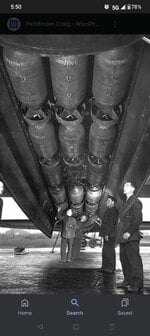MiTasol
Captain
This is going to depend on the bomb size and the plane.
The actual problem is getting crewman's hand/arm around the bomb to the lug/fitting to fasten the bomb in place. Also to fit the safety wires from the bomb rack to the fuses. And detach the bomb hoist cables from the larger bombs. With small bombs crewman may only to get his hand/arm around the bomb while sitting/kneeling/whatever under the bomb. Once they were dealing with large bombs (needs elbow along side the bomb or shoulder?) you need more 'clearance'. Some aircraft, like the B-17s, B-24s, B-26s had a walkway separating the left and right stacks of bombs and the crewmen could stand/kneel on the walkway and work on the top of the bombs. Some British bombers had access holes in the bomb bay ceiling for the bomb hoists to go through and for doing the fiddley bits with the latches/safety wires.
Another thing for 'clearance' is the angle at which the bombs could be dropped. Bombers could drop bombs at different angles of flight. Diving, climbing and/or banked. Some bombers had more latitude than others.
With a lot of British aircraft the bomb was attached to the rack on the ground and then the whole assembly winched into the aircraft. This made it very easy to adjust the sway braces that the RAF used on most, if not all, bombers. The first two items below are Beaufort where the 1,000lb and smaller bombs are lifted complete with rack and 2,000lb bombs and torpedoes are lifted after the rack is installed but by using winches built into the rack.
The Lancaster "small" bomb configuration - essentially the same
The Lancaster 8,000lb configuration
The sway braces (crutches) as used on 4 and 8,000lb bombs.

